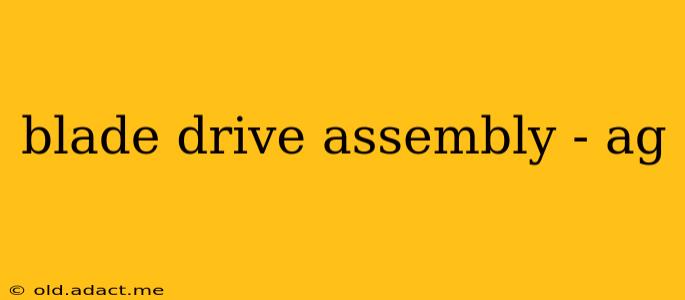Agricultural machinery relies heavily on efficient and robust blade drive assemblies to perform critical tasks like cutting, tilling, and harvesting. Understanding the components, maintenance, and troubleshooting of these assemblies is crucial for optimal machine performance and longevity. This comprehensive guide delves into the intricacies of blade drive assemblies in agricultural equipment.
What is a Blade Drive Assembly in Agricultural Machinery?
A blade drive assembly is the system responsible for transmitting power from the tractor's power take-off (PTO) or engine to the blades of various agricultural implements. This intricate system ensures the blades rotate at the correct speed and with sufficient torque to effectively perform their designated tasks. It's a crucial component in machinery such as mowers, tillers, hay balers, and harvesters. The specific design and components can vary significantly depending on the application and the manufacturer.
Types of Blade Drive Assemblies
Several types of drive assemblies exist, each suited to different applications and power requirements. These include:
-
Direct Drive: The simplest type, connecting the PTO shaft directly to the blade shaft. This offers simplicity and efficiency but lacks the flexibility for speed adjustment.
-
Belt-Driven Systems: These utilize belts and pulleys to transmit power, allowing for speed variations and increased protection against overloading. They are common in smaller implements.
-
Gear-Driven Systems: These use gears for power transmission, offering high torque and durability. This makes them suitable for heavier-duty applications and larger machines.
-
Hydraulic Drive Systems: More complex systems utilizing hydraulic motors and pumps. They provide precise control over blade speed and offer superior protection against overload. Often found in advanced, high-capacity machinery.
How Does a Blade Drive Assembly Work?
The precise mechanics depend on the type of drive assembly, but the fundamental principle remains consistent: power transmission. Let's consider a common gear-driven system as an example:
-
Power Source: The power originates from the tractor's PTO or engine.
-
Transmission: This power is then transmitted through a series of gears, often incorporating a gearbox for speed and torque adjustments.
-
Shafts: These gears are mounted on shafts that connect the gearbox to the blade shaft.
-
Blade Shaft: The blade shaft is directly connected to the cutting blades, causing them to rotate. This shaft often incorporates bearings and seals to minimize friction and maintain smooth operation.
-
Safety Mechanisms: Many assemblies include shear pins or clutches that protect the system from overloading by breaking or disengaging if excessive resistance is encountered.
What are the common components of an agricultural blade drive assembly?
Common components include the PTO shaft, gearbox (if applicable), universal joints (for flexible connections), drive shafts, bearings, seals, shear pins or clutches, and the blade shaft itself. The specific materials and construction of each component are carefully selected to ensure durability and reliability in challenging agricultural conditions.
How do I maintain my agricultural blade drive assembly?
Regular maintenance is crucial for preventing costly breakdowns. This includes:
-
Regular Lubrication: Lubricating all moving parts according to the manufacturer's recommendations is essential.
-
Inspection: Regularly check for wear and tear on belts, gears, shafts, and bearings. Replace worn components promptly.
-
Tightening: Check and tighten all bolts and fasteners regularly.
-
Cleaning: Keep the assembly clean and free from debris, especially around bearings and seals.
What are some common problems with agricultural blade drive assemblies?
Common problems include:
-
Broken Belts: Often caused by wear or overloading.
-
Worn Gears: Leads to reduced efficiency and potential failure.
-
Damaged Bearings: Causes increased friction and noise, eventually leading to failure.
-
Sheared Shear Pins: Indicates an overload situation; investigate the cause before replacing the pin.
-
Hydraulic Leaks (in hydraulic systems): May require professional repair.
Addressing these issues promptly will prevent further damage and ensure the continued efficient operation of your agricultural equipment. Always consult your machinery’s manual for specific maintenance procedures and troubleshooting guidelines. Understanding your blade drive assembly and practicing preventative maintenance is key to maximizing the lifespan and productivity of your agricultural machinery.
